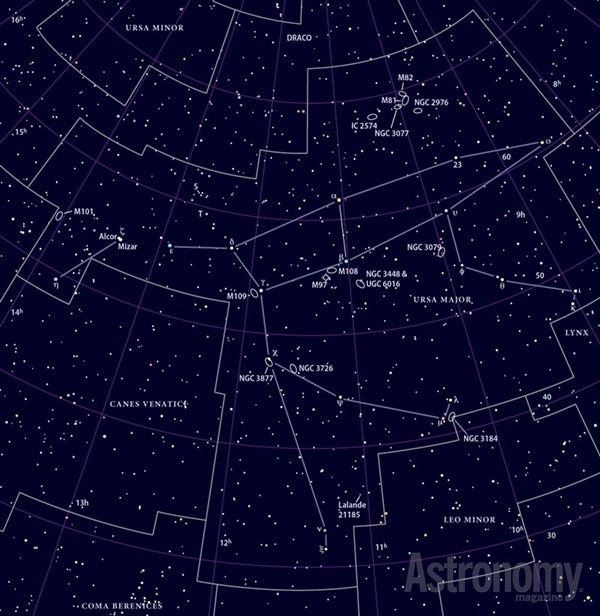Targets for March 20–27, 2014
Small telescope: Open cluster NGC 2546
Small telescope: Barred spiral galaxy NGC 3079
Large telescope: Irregular galaxy Sextans A
This week’s small-telescope target is the Heart and Dagger Cluster, also known as open cluster NGC 2546 in Puppis. You’ll find this object not quite 3° northeast of magnitude 2.3 Naos (Zeta [ζ] Puppis). It shines with naked-eye brilliance from a dark site and measures a whopping 70′ across. That means it covers a bit more area than five Full Moons.
Because it’s so large, this object really benefits from increased aperture. Through a 4-inch telescope, you’ll see about 15 stars generally strewn in a southeast to northwest direction. An 8-inch scope doubles the star count, and through a 14-inch instrument at a magnification of 150x, you’ll count 75 stellar points.
Two magnitude 6.4 stars will attract your attention immediately. One, SAO 198942, lies halfway from the cluster’s center to its southern border. The other, SAO 198848, sits off NGC 2546’s western edge.
The common name for this object originates with Astronomy magazine Contributing Editor Stephen James O’Meara. I’ve tried to see the complex figure of a heart pierced by a dagger he describes. If, like me, you can’t imagine that, try looking for a capital Greek letter Phi (Φ).
Thin is beautiful
This week’s first large-telescope object is barred spiral galaxy NGC 3079 in Ursa Major. You’ll find this object 2.2° northeast of magnitude 4.6 Phi Ursae Majoris. It glows at magnitude 10.9 and measures 8.0′ by 1.5′.
Yet another of the sky’s galactic “splinters,” NGC 3079 appears five times as long as it is wide. Through a 12-inch telescope at 300x, you’ll see that the bright central region stretches nearly two-thirds of the galaxy’s total length. If your sky is ultra-steady, you may spot the thin extensions that mark the spiral arms.
A nice triangle of relatively bright stars lies near the galaxy’s southern end. The brightest, magnitude 7.9 SAO 27476, lies 6′ south-southwest, magnitude 9.6 SAO 27482 sits less than 4′ southeast, and magnitude 9.5 SAO 27486 lies 7′ south-southeast. Finally, you’ll find the magnitude 13.0 elliptical galaxy NGC 3073 only 10′ to the west-southwest of NGC 3079.
Top of the class
This week’s second large-scope target is irregular galaxy Sextans A in (where else?) the constellation Sextans. This object is a member of our Local Group of galaxies.
At 4.3 million light-years away, it sits on the outskirts of this assembly. You’ll find it 5° west-southwest of magnitude 5.2 Delta (δ) Sextantis.
Through an 8-inch or larger telescope, this odd-looking magnitude 11.5 galaxy appears square. Not quite. It measures 5.9′ by 4.9′. If you use a 14-inch telescope to observe this object, crank up the magnification to 300x or higher and insert a nebula filter. Try to spot the galaxy’s brightest feature, an Hydrogen-II region at the southeastern edge.
And in case you’re wondering, the name “Sextans A” is an example of a radioastronomical name. Such a label combines a constellation’s name and an uppercase letter. Letters start at A and descend in order of brightness in radio wavelengths for such galaxies within a constellation. American astronomers John G. Bolton and Gordon J. Stanley introduced this system around 1950.
Expand your observing at Astronomy.com
StarDome
Check out Astronomy.com’s interactive StarDome to see an accurate map of your sky. This tool will help you locate this week’s targets.
The Sky this Week
Get a daily digest of celestial events coming soon to a sky near you.
Observing Talk
After you listen to the podcast and try to find the objects, be sure to share your observing experience with us by leaving a comment at the blog or in the Reader Forums.











